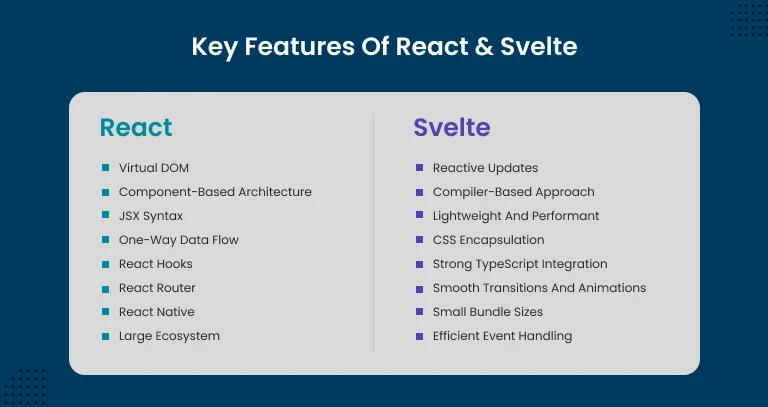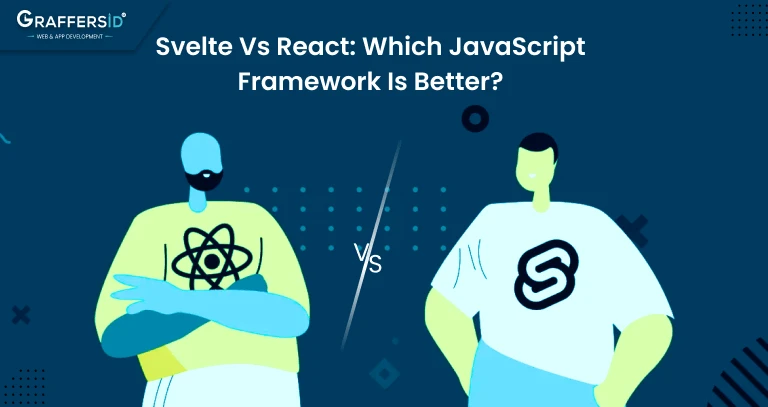When it comes to developing JavaScript applications, choosing the right framework is crucial. In today’s competitive landscape, two popular frameworks, Svelte vs React, have emerged as powerful contenders. Svelte, known for its lightweight and reactive nature, has gained traction for its unique compilation approach. React, on the other hand, has become a household name in the JavaScript ecosystem, valued for its flexibility and extensive community support.
This blog aims to provide a comprehensive comparison of Svelte vs React, helping developers, business owners, or CEOs to make informed decisions based on their project requirements.
What is Svelte?
Svelte is a modern JavaScript framework used for building user interfaces. It differs from traditional frameworks like React and Vue in its approach to rendering components. Instead of shipping a runtime library to the browser, Svelte compiles your code into highly efficient JavaScript code during the build process. This means that the bulk of the work is done at compile-time, resulting in a smaller and faster runtime for your applications.
Key features of Svelte:
-
Reactive updates:
Svelte leverages a reactive programming model, allowing you to define reactive statements that automatically update when the underlying data changes. This makes it easy to create dynamic and responsive user interfaces.
-
Compiler-based Approach:
Svelte takes a compiler-based approach, where components are compiled during the build process into efficient and optimized JavaScript code. This results in smaller bundle sizes and improved performance.
-
Lightweight and performant:
By compiling the code ahead of time, Svelte eliminates the need for a virtual DOM, resulting in smaller bundle sizes and faster initial rendering. The framework is known for its exceptional performance, making it an excellent choice for applications that prioritize speed and efficiency.
-
Small Bundle Sizes:
Due to its compiler-based approach and efficient code generation, Svelte produces smaller bundle sizes compared to some other frameworks. This results in faster loading times and improved overall performance.
-
CSS encapsulation:
Svelte offers built-in support for scoped styles, allowing you to define CSS styles that are encapsulated within a component. This helps avoid style collisions and makes it easier to maintain and manage stylesheets.
-
Smooth transitions and animations:
Svelte provides a powerful transition system that simplifies the creation of smooth animations and transitions between UI states. This feature enhances the user experience and adds a polished feel to your applications.
-
Strong TypeScript integration:
Svelte has excellent support for TypeScript, a typed superset of JavaScript. This integration provides static type-checking and enhanced tooling capabilities, making it easier to catch errors and maintain code quality.

What is React?
React is a popular JavaScript library for building user interfaces. It was developed by Facebook and is widely used in web development, including single-page applications, mobile applications, and even desktop applications. React follows a component-based architecture and focuses on efficient UI rendering and state management.
Key Features of React include:
-
Virtual DOM:
React uses a virtual DOM (Document Object Model) to efficiently update and render UI components. The virtual DOM is a lightweight representation of the actual DOM, allowing React to optimize updates by minimizing the number of changes needed to be applied to the real DOM.
-
Component-based architecture:
React encourages a modular approach to UI development through its component-based architecture. Components are reusable, self-contained building blocks that encapsulate their own logic, styles, and markup. This modularity promotes code reusability, maintainability, and separation of concerns.
-
JSX syntax:
React utilizes JSX (JavaScript XML), which is an extension of JavaScript that allows you to write HTML-like syntax within your JavaScript code. JSX makes it easier to define the structure and appearance of components, enhancing the readability and maintainability of the code.
-
One-way data flow:
React follows a unidirectional data flow pattern, where data flows in a single direction from parent components to child components. This ensures predictable data flow and makes it easier to understand how data changes propagate throughout the application.
-
React Hooks:
Introduced in React 16.8, hooks are a feature that allows functional components to manage state and side effects. Hooks provide a simpler and more concise way to handle component states, lifecycle methods, and other functionalities, reducing the need for class components.
-
React Router:
React Router is a popular routing library for React applications. It provides a declarative way to define routing in your application, allowing you to navigate between different components based on the URL.
-
React Native:
React Native is a framework that allows developers to build native mobile applications using React. With React Native, you can write mobile apps using React’s component model and have them run on iOS and Android devices, sharing a significant amount of codebase.
-
Large ecosystem and community:
React has a thriving ecosystem with a vast number of third-party libraries, tools, and extensions available. This extensive ecosystem offers solutions for various aspects of development, such as state management (Redux, MobX), UI components (Material-UI, Ant Design), and testing frameworks (Jest, Enzyme).
-
Developer tools:
React provides a set of developer tools that aid in debugging, inspecting component hierarchies, and monitoring performance. The React DevTools extension, combined with browser developer tools, allows developers to efficiently debug and optimize their React applications.
Advantages & Disadvantages of Svelte
Svelte, a modern JavaScript framework for building user interfaces, offers several advantages that make it a compelling choice for developers. However, like any technology, it also comes with certain drawbacks. In this section, we will explore the advantages and disadvantages of using Svelte in your web development projects.
Advantages of Svelte:
-
Performance:
One of the key advantages of Svelte is its exceptional performance. Svelte compiles the code during the build process, resulting in highly optimized JavaScript that is executed directly in the browser. This approach eliminates the need for a virtual DOM and reduces the runtime overhead, leading to faster initial rendering, smaller bundle sizes, and improved overall performance.
-
Developer Experience:
Svelte offers a smooth and enjoyable development experience. The framework’s declarative syntax and reactive updates make it easy to build dynamic and responsive user interfaces. Svelte’s component-based architecture promotes code reusability and modularity, enabling developers to create self-contained and maintainable components.
-
Easy Learning Curve:
Svelte has a gentle learning curve, especially for developers familiar with HTML, CSS, and JavaScript. Its syntax is intuitive and straightforward, allowing developers to quickly get started and build applications without having to learn complex abstractions or additional tooling.
-
Built-in State Management:
Svelte provides built-in state management capabilities through reactive declarations and stores. These features make it easy to handle and manage the application state, simplifying the process of handling data changes and enabling efficient reactivity.
-
Small Bundle Sizes:
With Svelte, you can achieve smaller bundle sizes compared to some other frameworks. The compiled output of Svelte is highly optimized and only includes the necessary code, resulting in smaller payloads that load faster, especially on low-bandwidth or mobile networks.
-
Scoped Styles:
Svelte offers built-in support for scoped styles, allowing you to encapsulate CSS styles within individual components. This feature helps avoid style conflicts and makes it easier to maintain and manage stylesheets in larger applications.
Disadvantages of Svelte:
-
Less Mature Ecosystem:
While Svelte’s ecosystem has been growing steadily, it is still relatively smaller compared to more established frameworks like React or Vue. This means that the availability of third-party libraries and plugins may be more limited in comparison. However, Svelte does have its own set of libraries and tools, and the ecosystem is expanding as the framework gains popularity.
-
Limited Tooling Support:
Svelte has fewer development tools and integrations compared to more mature frameworks. Although Svelte has its own compiler and bundler, the ecosystem for tooling and integrations is not as extensive as some other frameworks. However, the core tooling provided by Svelte is robust and efficient for most development needs.
-
Steeper Learning Curve for Advanced Features:
While the basics of Svelte are relatively easy to grasp, diving into more advanced features may require a deeper understanding of reactive programming and the framework’s internals. Some of the more powerful and advanced features of Svelte, such as custom compiler macros or fine-grained optimizations, might require more experience and familiarity with the framework.
-
Limited Community Support:
Compared to more established frameworks, the size of the Svelte community is still growing. As a result, finding community support, tutorials, or answers to specific questions may sometimes be more challenging. However, the community is active and supportive, and resources are increasingly becoming available as the framework gains popularity.
Advantages & Disadvantages of React
React, a widely used JavaScript library for building user interfaces comes with a range of advantages that have contributed to its popularity among developers. However, like any technology, React also has its own set of disadvantages. In this blog section, we will explore the advantages and disadvantages of using React in your web development projects.
Advantages of React:
-
Virtual DOM and Efficient Rendering:
React’s virtual DOM allows for the efficient rendering of UI components. By comparing the virtual DOM with the actual DOM and applying only the necessary updates, React minimizes the number of expensive real DOM operations, resulting in improved performance and a smoother user experience.
-
Component-Based Architecture:
React promotes a component-based architecture, which enables developers to create reusable and modular UI components. Components encapsulate their own logic, styles, and markup, making code more organized, maintainable, and easier to debug. This modular approach also allows for easy collaboration among developers.
-
Large Ecosystem and Community:
React has a vast and thriving ecosystem with a wide range of libraries, tools, and extensions. This rich ecosystem provides solutions for various aspects of development, such as state management, routing, testing, and UI component libraries. The large community around React ensures that developers have access to abundant resources, tutorials, and community support.
-
React Native:
React Native, an extension of React allows for building native mobile applications using JavaScript. With React Native, developers can leverage their React skills to create mobile apps for iOS and Android platforms, sharing a significant amount of codebase. This enables faster development cycles and cost-effective cross-platform app development.
-
Developer Tools:
React offers a set of powerful developer tools that aid in debugging, inspecting component hierarchies, and performance monitoring. The React DevTools extension, combined with browser developer tools, provides a comprehensive toolkit for efficiently developing and optimizing React applications.
Disadvantages of React:
-
Steep Learning Curve:
React’s learning curve can be steep, especially for developers new to the library or those without prior experience with JavaScript frameworks. React introduces concepts such as JSX syntax, virtual DOM, and unidirectional data flow, which may require time and effort to fully grasp and utilize effectively.
-
Complexity for Small Projects:
React, with its robust ecosystem and tooling, can be overkill for small projects or simple websites. The additional setup and configuration required for React development may outweigh the benefits for projects with minimal interactivity or limited UI complexity. In such cases, a simpler library or framework may be more suitable.
-
Choice Paralysis:
React’s popularity has led to the availability of numerous libraries, tools, and architectural patterns. This abundance of options can sometimes result in decision paralysis, making it challenging to choose the right tools and libraries for specific project requirements. Careful consideration and research are required to avoid unnecessary complexity and maintain project coherence.
-
Performance Impact of Reconciliation:
While React’s reconciliation algorithm is optimized for efficient rendering, complex component hierarchies or frequent state updates can impact performance. Care must be taken to optimize the component structure, use proper shouldComponentUpdate or memoization techniques, and avoid unnecessary re-rendering to maintain optimal performance.
When Should You Use Svelte and React?
Choosing the right JavaScript framework for your web development projects is crucial to ensure efficient development, optimal performance, and a positive developer experience. Svelte and React are both powerful options with their own strengths and use cases. In this blog section, we will explore when you should consider using Svelte vs React in your projects.
When to Use Svelte:
-
Performance-Centric Applications:
Svelte excels in scenarios where performance is a top priority. Its compilation-based approach results in smaller bundle sizes, faster initial rendering, and efficient updates, making it ideal for applications that require lightning-fast user interfaces and optimal loading times.
-
Prototyping and Small Projects:
Svelte’s simplicity and gentle learning curve make it an excellent choice for prototyping or building small-scale projects. With minimal setup and configuration, developers can quickly start building UI components using Svelte’s intuitive syntax, reactive updates, and built-in state management.
-
Projects with Limited Tooling Requirements:
Svelte offers a well-rounded set of core tools and features, making it suitable for projects that don’t require extensive tooling support or integrations. If you prefer a framework with a smaller footprint and are comfortable with a more streamlined ecosystem, Svelte may be a good fit.
-
Faster Time-to-Market:
Due to its efficiency and ease of use, Svelte can help accelerate development timelines, making it advantageous for projects with tight deadlines or when rapid iteration is required. Svelte’s concise syntax and efficient updates enable developers to focus on building features rather than boilerplate code.
When to Use React:
-
Large and Complex Applications:
React’s component-based architecture and rich ecosystem make it an excellent choice for large-scale applications with complex UI requirements. Its modular approach facilitates code organization, reusability, and maintainability, which are crucial for managing intricate application structures.
-
Mature Ecosystem and Extensive Tooling:
React’s popularity has resulted in a vast ecosystem with a wide range of libraries, tools, and extensions. If your project can benefit from the extensive selection of pre-built UI components, state management solutions, routing libraries, and testing frameworks, React offers a mature ecosystem with ample community support.
-
Mobile App Development:
If you’re targeting mobile platforms, React Native, an extension of React, is a powerful option. React Native allows for building native iOS and Android applications using familiar React concepts, enabling code sharing and reducing development efforts across multiple platforms.
-
Projects Requiring Advanced State Management:
React’s unidirectional data flow and popular state management solutions like Redux or MobX make it a solid choice for applications with complex state management needs. If your project involves handling a large amount of shared or synchronized state across components, React’s state management capabilities can simplify the process.
-
Performance Optimization and Fine-Grained Control:
React provides a comprehensive set of developer tools and optimization techniques to fine-tune performance. If your project requires detailed control over rendering, optimizations, or deeper integration with other tools or frameworks, React’s robust tooling and community support offer the necessary resources.
Key Difference Between Svelte vs React
Here’s a table comparing Svelte and React across different aspects:
| Aspect | Svelte | React |
|---|---|---|
| Performance | Exceptional performance due to compiled output | Efficient rendering with virtual DOM |
| Learning Curve | Relatively easy to learn with intuitive syntax | The steeper learning curve, especially for beginners |
| Component Architecture | Component-based architecture for code reusability | Component-based architecture for code reusability |
| State Management | Built-in state management through reactive declarations | Requires external libraries like Redux or MobX |
| Ecosystem | A growing ecosystem with a smaller but active community | A vast ecosystem with extensive libraries and tools |
| Tooling Support | Core tooling provided, with limited external integrations | Extensive tooling support and integrations are available |
| Mobile Development | Not specifically designed for mobile development | React Native allows native mobile app development |
| Performance Optimization | Limited optimization options, but efficient by default | Offers advanced optimization and fine-grained control |
| Developer Experience | Smooth and enjoyable development experience | Provides a robust development environment |
| Project Size | Well-suited for small to medium-sized projects | Suitable for projects of any size, including large ones |
Which Companies Use Svelte and React?
Svelte and React have widely adopted JavaScript frameworks that have gained popularity in the web development community. Many companies, both large and small, have embraced these frameworks to build powerful and scalable applications. In this blog section, we’ll take a look at some notable companies that use Svelte and React in their tech stacks.
Companies that use Svelte:
Netflix: Netflix, one of the world’s leading streaming platforms, utilizes Svelte in its user interface to deliver a smooth and responsive browsing experience to millions of users worldwide.
Microsoft: Microsoft has incorporated Svelte into various projects, including its Azure Portal, a web-based interface for managing Azure cloud services. Svelte’s performance advantages make it an ideal choice for delivering a seamless user experience in complex applications.
Spotify: The popular music streaming platform Spotify has also adopted Svelte for certain components of its web application. Svelte’s efficient rendering and small bundle sizes align well with Spotify’s focus on delivering a fast and optimized user experience.
IBM: IBM, a global technology company, has utilized Svelte in its internal tools and applications. Svelte’s ease of use, performance benefits, and modular architecture make it an attractive option for building internal tools within large organizations.
Companies that use React:
Facebook: React was developed by Facebook, and it remains an integral part of the company’s technology stack. React powers several Facebook products, including the Facebook website and its mobile applications.
Instagram: Instagram, the popular social media platform, relies on React for its web interface. React’s component-based architecture and efficient rendering enable Instagram to deliver a rich and interactive user experience.
Airbnb: Airbnb, an online marketplace for vacation rentals and experiences, utilizes React in its web application. React’s reusability and performance optimizations help Airbnb handle large amounts of dynamic content while providing a seamless user experience.
WhatsApp: The popular messaging application WhatsApp, owned by Facebook, employs React in its web client. React’s ability to efficiently manage real-time updates and handle complex UI interactions is essential for a messaging platform of this scale.
Netflix: While Netflix uses Svelte in certain areas, it also utilizes React in other parts of its web application. React’s extensive ecosystem and community support make it a reliable choice for Netflix to build and maintain its feature-rich streaming platform.
Svelte vs React: Who Wins in 2023?
Determining which framework “wins” in 2023 ultimately depends on your specific project requirements and development context. React’s established ecosystem, extensive community support, and flexibility make it a safe and versatile choice for a wide range of applications, especially large-scale and complex projects. Its performance optimizations, combined with powerful developer tools, make it suitable for optimizing user experiences.
Svelte, with its focus on performance and simplicity, is an excellent choice for projects where fast loading times and highly efficient rendering are paramount. Its intuitive syntax and reactive nature makes it well-suited for prototyping, smaller projects, or situations where rapid development and ease of use are important factors.
In conclusion, both React and Svelte have their strengths and can deliver exceptional results based on your project’s specific needs. It’s important to carefully evaluate the requirements, consider the learning curve, assess performance needs, and weigh the available ecosystem and community support before making a decision. Ultimately, the “winner” in the React vs Svelte battle will depend on which framework aligns best with your project goals and development preferences in 2023.
Hire Dedicated Remote React.js Developers for Your Project from Graffersid
Are you looking to build a robust and scalable web application using React.js? Do you need highly skilled and dedicated developers to bring your project to life? Look no further! GraffersID is here to help.
We specialize in providing top-notch remote React.js developers who are experienced in crafting innovative and high-performance applications. Whether you’re starting a new project or need additional resources to scale your existing team, our talented developers can seamlessly integrate into your workflow and deliver outstanding results.
Why Choose Graffersid?
-
Expertise and Experience:
Our team consists of skilled React.js developers who have a deep understanding of the framework and its ecosystem. They have successfully delivered numerous projects across various industries, bringing their expertise to each endeavor.
-
Dedicated Resources:
When you hire from Graffersid, you get dedicated developers solely focused on your project. They become an extension of your team, working closely with you to ensure your vision is brought to life with precision and efficiency.
-
Flexible Engagement Models:
We understand that each project is unique, so we offer flexible engagement models to cater to your specific needs. Whether you require developers for a short-term project or a long-term partnership, we can customize our services to fit your requirements.
-
Quality Assurance:
Quality is our utmost priority. Our developers follow industry best practices, coding standards, and thorough testing procedures to ensure your application meets the highest standards of functionality, performance, and security.
Don’t compromise on the quality and success of your React.js project. Partner with Graffersid and gain access to a talented pool of remote developers who are dedicated to turning your ideas into reality.
Take the next step and contact us today to discuss your project requirements and hire dedicated remote React.js developers from Graffersid. Let us be your trusted technology partner and bring your vision to life with expertise and excellence.




